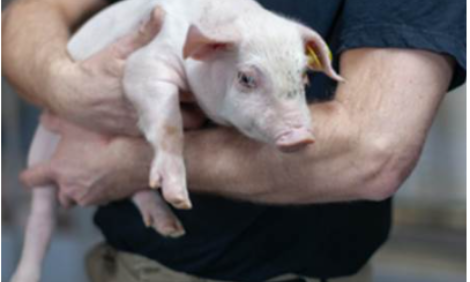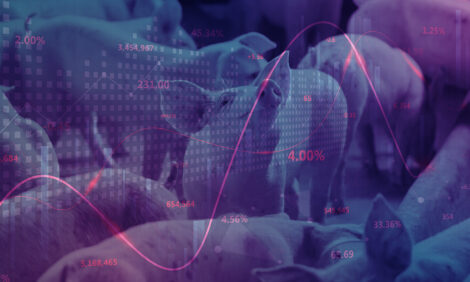



Gestation Housing for Sows: Studies on Electronic Sow Feeders & Stalls
By Harold W. Gonyou, Ontario Pork Newsletter - The housing for gestating sows is one of the most controversial aspects of pig production (AAFC, 1993), and forms the basis for most criticism of the animals' welfare. The primary issue is the restriction of movement in gestation stalls, the most common form of management (Gonyou, 1996).Background
In a review of relevant literature to that date, den Hartog et al. (1993) identified several alternatives to stall housing, and concluded such systems are likely to improve rapidly as efforts are directed toward controlling the problems encountered. Of the various group housing systems identified, the electronic sow feeder (ESF) is the one most capable of providing control over each individual's feed intake, and reducing the social aggression encountered at the time of feeding.
Several studies have compared the ESF system with conventional stalls. When comparing housing systems, common means of welfare assessment include skin lesions (Boyle at al., 2002), locomotion (Morris et al., 1997), muscle weight and bone strength (Marchant and Broom, 1996), salivary cortisol, immune response, reproduction and social behaviour (Mendl et al., 1993).
The study by Mendl et al. (1993) indicates that the most stressful period within the ESF system is during the first few gestations, and that older sows experience a high level of welfare. They also concluded that additional research is needed into the social management of sows in ESF systems. For example, Moore et al. (1993) reported that sows introduced to an existing group take several weeks to integrate into the new social environment.
Although restrictive of the animals' movements, gestation stalls are the most common system used within Canada. One of the problems encountered in the industry is a gradually increasing degree of restriction due to the increase in mature body size of pigs selected for rapid growth, and the reduction in stall width in order to conserve space.
Although the Code of Practice (AAFC, 1993) suggests that farms might maintain several different sizes of stalls to accommodate various sized sows, few farms take this into account. Research on the allometric dimensions of sows (static space) and the space required to freely stand up and lie down (dynamic space) suggests that few gestation stalls provide adequate space for the animals (Baxter and Schwaller, 1983; Curtis et al., 1989). There is a need for additional information relating sow behaviour to sow size and stall dimensions (Anil et al., 2002).
Progress to date
In order to initiate the studies to accomplish objectives 1 and 2 the breeding herd needed to be re-organized such that animals (other than gilts) would have experienced their housing treatment for at least one gestation before data collection began.
The 20 breeding weeks of the farm reproductive cycle were assigned to four 5-week blocks. Each block consisted on one week assigned to each treatment: Add-in Static, Static, Add-in Dynamic, Dynamic, and Stall. All animals to be maintained in electronic sow feeder (ESF) groups were trained to feed from the stalls.
Within the Static program, all females bred during one week (sows bred in stalls, gilts in the training pen) were assigned to a Static group. This group was housed in a single pen equipped with one ESF station.
Standard practice was to simultaneously introduce bred gilts and sows to the pen 10 days after the sows were weaned . They remained in the group until removed for farrowing or to join another group upon repeat breeding. Following farrowing and subsequent re-breeding, those animals that stay ‘on cycle’ will once again be in a Static group.
Management within the large group Dynamic program housed the animals in a single large pen, equivalent to three Static pens, equipped with three ESF stations. Every 5 weeks a group of sows was removed for farrowing, and a recently bred group was added. At any time three weekly breeding groups were present in the large gestation pen, and one was in farrowing or breeding.
The Add-In groups, represented animals introduced to ESF pens after fetal implantation, were super-imposed upon the Static and Dynamic groups (pre-implantation) described above. Add-In groups were obtained from previous weekly breeding groups.
Animals in Add-In groups were housed in gestation stalls for six weeks following breeding, and combined with Static or Dynamic groups when they were moved into ESF pens. Sufficient animals were used to achieve a group size of 40-45. These animals entering the gestation groups at >40 days post-breeding were removed for farrowing before the remainder of the gestation group.
During the subsequent reproductive cycle, production and injury data were collected as described in the proposal. Some of the results of this first experimental reproductive cycle for objectives 1 and 2 are summarized in the following tables:
| Static | Add-in Static |
Dynamic | Add-in Dynamic |
Stalls | Total | |
| Gilts | 32 | 31 | 36 | 32 | 29 | |
| Young sows | 23 | 17 | 15 | 6 | 20 | |
| Old sows | 44 | 26 | 37 | 37 | 74 | |
| Total | 99 | 74 | 88 | 75 | 123 | 459 |
| Static | Add-in Static |
Dynamic | Add-in Dynamic |
Stalls | SE | |
| Gilts | 75 | 71 | 75 | 78.1 | 82.8 | |
| Young sows | 91.3 | 82.4 | 86.7 | 83.3 | 90 | |
| Old sows | 84.1 | 100 | 70.3 | 85.3 | 88.7 | |
| Total | 82.5 | 83.8 | 76.4 | 86.7 | 90.4 | 3.95 |
| Static | Add-in Static |
Dynamic | Add-in Dynamic |
Stalls | SE | |
| Gilts | 10.9 | 9.4 | 9.6 | 10.6 | 9.3 | |
| Young sows | 8.7 | 11.1 | 9.8 | 8.6 | 10.9 | |
| Old sows | 11.1 | 11.6 | 11.0 | 11.0 | 10.6 | |
| Total | 9.95 | 10.69 | 10.10 | 10.06 | 10.26 | 0.41 |
The second reproductive cycle is nearing completion.
Work on the third objective was initiated during the first year of the project. PSC-Elstow is equipped with four widths of gestation stalls: 55 cm (22”), 60 cm (24”), 65 cm (26”), and 70 cm (28”). All stalls are 2.1 m in length. To this point several sows from each of 1st to 6th parity were assigned to each of the 4 stall widths, with the exception that no bred gilts were housed in 70 cm stalls as our experience is that they are able to turn around in this size of stall. The animals were weighed and assigned to a stall approximately 10 days after breeding, and remained in that stall throughout their gestation.
The incidence of injuries (calluses, scratches and cuts on 20 regions of the body) was assessed at allotment and at the end of each trimester of gestation. The posture and movement of the sows were assessed near the end of the 1st and 3rd trimester by means of direct observation. The proportion of time spent in major postures was assessed using interval observations, while the frequency and duration of major posture changes were assessed during continuous observations sampled over a 24-hr period.
Source: Ontario Pork, July 2003









